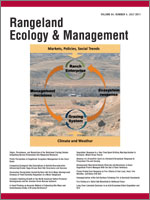Landspraying while drilling (LWD) is an approved disposal method for water-based drilling mud (WBM) systems in western Canada. The mud is applied either on cultivated land, where it is incorporated by cultivation, or on vegetated land where it is not incorporated. This study examined the effects of summer WBM application (0, 15, 20, 40, and 80 m3 · ha−1) on native vegetation properties. Our results indicated that LWD increased bare ground but decreased lichen cover at the 80 m3 · ha−1 rate relative to the untreated control. Nitrogen (N), sulfur (S), and magnesium (Mg) concentrations in aboveground plant tissue increased with increasing LWD rate in samples taken 45 d after WBM application, but these differences disappeared 1 yr after treatment. Increase in tissue concentration of phosphorus (P) with LWD rate, however, was only detected 3 yr after LWD. Nonetheless, these changes in tissue chemistry were not associated with significant changes in biomass yield or species composition. Overall, our results suggest that single WBM applications at rates (≤ 20 m3 · ha−1) commonly used in western Canada, if properly managed, are unlikely to adversely affect native prairie vegetation.
How to translate text using browser tools
1 July 2011
Vegetation Response to a One-Time Spent Drilling Mud Application to Semiarid, Mixed-Grass Prairie
Francis Zvomuya,
Francis J. Larney,
Walter D. Willms,
Ryan K. Beck,
Andrew F. Olson
ACCESS THE FULL ARTICLE

Rangeland Ecology and Management
Vol. 64 • No. 4
July 2011
Vol. 64 • No. 4
July 2011
biodiversity
energy exploration
hydrocarbon extraction
native rangeland
oil and natural gas




